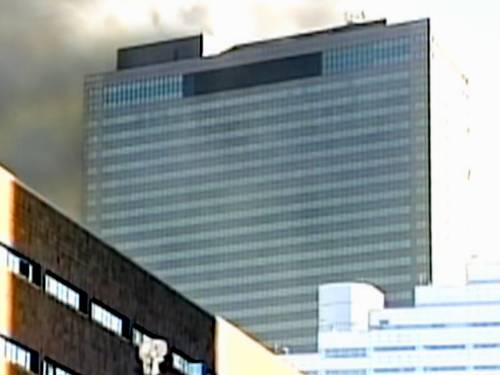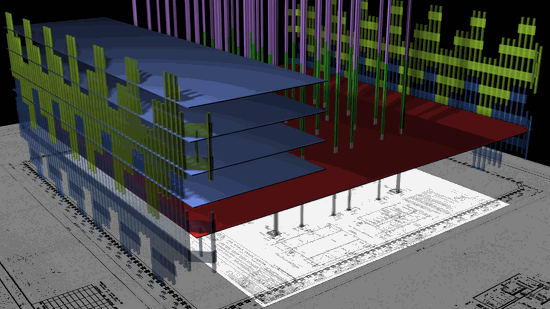femr,
There was no discussion of engineering about the core model, simply your misinterpretation of it's scope. Your utter lack of comprehension and understanding, along with the kind of rudeness you seem to relish in here, led to your being temporarily suspended by a moderator.
LMAO.
Yeah, it IS a subjective world, ain't it.
The principle fracas that I recall was you're building a model of the immense core columns, which were muscled into place by hand by a bunch of union welders, at breakneck speed, without fixturing, with the columns dangling by chains from jump jacks, 80 stories in the sky, and frequently in, shall we say, "breezy" conditions...
... and quoting the location of those columns to, what was it again... 13 significant digits.
And I recall my chiding you for it.
And I recall, you did not reply with the ONLY reasonable reply: "oh yeah, I just didn't round them off. Ignore everything after the 3rd digit".
Instead, from you and that (what is the term for a group of truthers?) Hornswaggle of truthers, I got a chorus of objections about how little I understand about modeling...!!?
Sure thing, femr. That was MY lack of comprehension & understanding.
Sure thing, femr. You understand about "precision in measurement".
Sure thing, femr. The hostile response to my posting had absolutely nothing to do with the fact that there were 20 active truthers posting there. And, at that time, just me speaking for the other side.
Sure thing.
Have you completed your analysis yet ?
You'll know when it's done. I'll post it here.
I am not, unlike yourself (most humerously), going to begin the process of interpreting the data until I've completed it's extraction. I've told you this several times.
I asked a simple, direct question.
I'm not asking you for a final answer.
IF the northeast corner is moving at least 4 full seconds before the collapse initiation began (as your preliminary data SUGGESTS), then what does this say about the the final collapse being either a separate event from the previous collapses (e.g., the east penthouse) versus being part of a continuous process.
Ever heard the term "speculation"? Contrary to the misapprehensions of people who have never participated in the process, all engineering inquiry starts with speculation.
People who participate toss out ideas. No matter how wild. You usually don't believe what you propose to be true.
But the speculation leads you to a sequence of "if this is true, we should then see that..." And this is progress.
In the engineering field, we have a term for folks who refuse to offer their speculation: "cowards".
Not that I'm calling you one, femr. Of course, I'm not. You're not an engineer.
I'm just relating conversations that I've had with lots & lots of engineers over the years as we sat around speculating, while trying to figure something out.
This is one of your substantial questions ? LOL. It's a stupid question. Apply whatever brand to me as you please for your own purposes. What I post can stand on it's own merits.
I'm encouraging you to speak your mind plainly.
This is a simple "forest vs the trees" moment, guy. It's been 9 1/2 YEARS. Surely, some tiny little conclusion has percolated its way into your brain.
You'll have to forgive me my engineer's bluntness. But we consider people who won't speak their minds, plainly & publicly, to be wimps.
The *moire* technique applied by NIST is not actually a true moire effect. There are no intersecting lines, only the pixel delineation.
100% wrong. You don't know what you're talking about. It is EXACTLY a Moire effect.
Not "approximately". Not "pseudo-".
It's simply a method they've used to identify horizontal movement by applying a *property* of a moire analysis.
Yep, the properties being the spacial frequency of 3 columns of pixels in the camera and the nearly (but not exactly) parallel edge of the building.
Clearly, you didn't understand what NIST really said.
The methods I use (*8 upscale with Lanczos3 filtering) achieves the same result without resorting to the dodgy non-linear side-effect of finding a centre-spot in intensity. They both work on the same principle...small sub-pixel movements result in adjacent pixel intensity changes, which can be tracked. NIST have simply chosen to track those intensity changes in a vertical direction, though they are using a non-vertical building feature and non-linear intensity change metric to define their distance translations, and taking account of neither.
LMAO...
What a word salad.
You have absolutely no idea what NIST did here, do you?
Their technique & yours have nothing in common. Here's the proof:
You're process is symmetric for motions in all directions. Moire has an amplification of a factor of 100x for motion in the horizontal direction & no amplification (gain = 1) in the vertical.
Your technique needs to see the pixel that you are tracking. Moire doesn't.
Your technique works for any size, shape, geometry of building. Moire requires two nearly parallel features, one with a spacial or temporal frequency, and works best when the two features are nearly, but not exactly parallel. In essence, Moire works because of interference fringing between two spacial frequencies (or one frequency & one fixed reference).
You'd best read up on it. NIST explains it clearly.
They should have used a better method for the roofline trace then. The methods I use work in both directions.
Your method works in all directions. Theirs doesn't. Proof that you're contradicting your own comment that "they are based on the same principle."
I don't think confusion comes into it in the slightest Tom. Digging yourself out of a hole, and failing miserably is more like it.
LMAO. Sure thing, femr. Why don't you go ask one of your truther buddies to explain Moire (& NIST's use of it) to you.
No. Their hotch-potch *moire* method suffers from non-linear intensity changes, which they did not account for in their translation to real-world units. I can explain in mo(i)re detail if you like. But I suggest you check figure C-7 first though.
Friggin' priceless.
Sure thing, femr. Why don't YOU explain Moire to all of us.
The graph I included just a post previous shows you that the accuracy of my methods is very comparable to NISTs results in the horizontal direction. I doubt you understand why.
"... very comparable to..."
Silly me. I'd simply say that "NIST has this
Dead link. But I'm not looking for the proximal source. I'm looking for the pedigree back to the original recording.
tfk said:
You say that it's 59.9 frames/sec.
Yep. Original framerate, which is 59.94 fps.
Hmmm, broadcast video in the US. NTSC-M.
Every NTSC-M spec that I've seen says 29.97 FRAMES per second, and 59.94 FIELDS per second.
I'll await your, you know, "proof" for how the original frame rate was 59.8 frames/sec. And exactly how it got that way.
... your repeated previous use of the phrase *reinterlaced*.
Yeah, we've been down this road before.
When you've got little else, I guess you can fall back on vernacular.
Ahh, vernacular.
We've talked about this before. I know what the process is, how it works & why they do it.
Put it this way, femr. You use the term "loo". And I don't claim that you know nothing about indoor plumbing.
No. MPEG-2 video data is interlaced, so contains 2 separate frames in each single frame of the resultant video. Once interlaced, each separate frame is then termed as a field.
Lemme see if I follow your claims...
"A frame is really two frames. Except a frame is broken into two frames, it becomes a field."
Ahhhh, I don't think so.
I think each frame is made up of two fields. I think a frame is not two frames. And two frames is not a frame.
And I think that there are times when a 30 fps frame is broken up into two 60 field per second fields. And then, for a variety of reasons, someone might be interested in converting each of those fields into a complete frames at 60 fps.
So they do so in one of two ways: either duplicating each line into the line below it, in order to maintain aspect ratio. Or by using interpolation algorithms using the previous & succeeding fields.
In the first case (line duplication), each frame has no more info in it than the field did. In other words, half as much info as a typical frame.
In the second case (interpolated fill), the frame will have as much info as a normal frame.
Show me, with something other than "femr says", that this is not so with this video.
I deinterlace the video as part of it's preparation for tracing.
YOU "deinterlace the videos"??
And here, just a moment ago, I could have SWORN that you said that the raw video was 60
full frames per seconds.
Now, why would one have to deinterlace 60 fps full frame video?
Where would one even stick the new lines.
Now, if one had 60 FIELD per second video, then deinterlacing to achieve 30 FRAME per second video makes sense.
But you just adamantly asserted that was not the case.
... but then you said you deinterlaced them...?
'Tis a mystery.






















